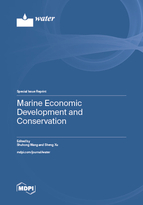Marine Economic Development and Conservation
A special issue of Water (ISSN 2073-4441). This special issue belongs to the section "Oceans and Coastal Zones".
Deadline for manuscript submissions: closed (20 May 2023) | Viewed by 31881
Special Issue Editors
Interests: economics; marine economics; environmental economics; economic development; efficiency
Special Issues, Collections and Topics in MDPI journals
Special Issue Information
Dear Colleagues,
As an important carrier of modern economic development and social activities, the ocean is not only a natural basis for ecologically sound and sustainable development, but also a new growth pole for economic breakthroughs and innovations and a key component of the overall composition of social development, but at the same time, it may also turn into a bottleneck and a hidden danger that restricts socioeconomic development. As the strategic position of the ocean continues to be highlighted, issues such as high-quality development of the marine economy, resource accounting and management, efficiency and management, ecological compensation and security, marine bearing capacity measurement, and the construction of monitoring and early warning and management systems have become increasingly important. More and more scholars believe that the quality of marine resources and environment is deeply related to the level of human economic development and society’s environmental policy response. Although the development and utilization of marine resources are the only way to achieve a “strong ocean state”, if the rapid development of regional marine economy is really at the cost of rapid consumption of marine resources and the environment, then the economic development-oriented marine economic development model will eventually lead to the depletion of marine resources and the exposure of environmental problems. The recent rapid development and application of the digital economy, artificial intelligence, big data, and cloud computing technologies provide new opportunities for the development and protection of marine economy. Appropriate methods are selected to explore the development of marine economy and meet the needs of the goal of sustainable development and protection of marine economy.
Prof. Dr. Shuhong Wang
Prof. Dr. Sheng Xu
Guest Editors
Manuscript Submission Information
Manuscripts should be submitted online at www.mdpi.com by registering and logging in to this website. Once you are registered, click here to go to the submission form. Manuscripts can be submitted until the deadline. All submissions that pass pre-check are peer-reviewed. Accepted papers will be published continuously in the journal (as soon as accepted) and will be listed together on the special issue website. Research articles, review articles as well as short communications are invited. For planned papers, a title and short abstract (about 100 words) can be sent to the Editorial Office for announcement on this website.
Submitted manuscripts should not have been published previously, nor be under consideration for publication elsewhere (except conference proceedings papers). All manuscripts are thoroughly refereed through a single-blind peer-review process. A guide for authors and other relevant information for submission of manuscripts is available on the Instructions for Authors page. Water is an international peer-reviewed open access semimonthly journal published by MDPI.
Please visit the Instructions for Authors page before submitting a manuscript. The Article Processing Charge (APC) for publication in this open access journal is 2600 CHF (Swiss Francs). Submitted papers should be well formatted and use good English. Authors may use MDPI's English editing service prior to publication or during author revisions.
Keywords
- marine economics
- marine environment
- management and efficiency
- economic security
- high-quality development
Related Special Issue
- Marine Bearing Capacity and Economic Growth in Water (4 articles)







